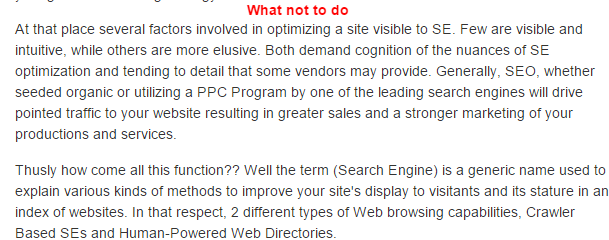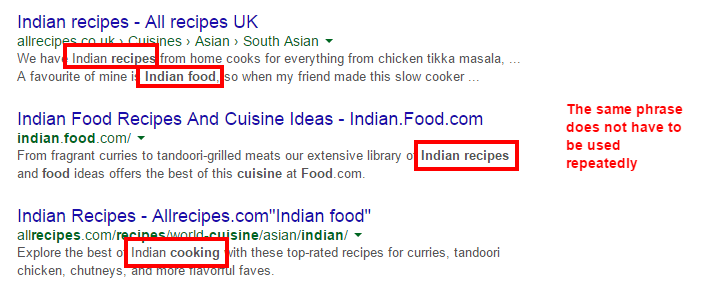SEO copywriting has a bad name, and there is a good reason for this: years of barely literate content, spat out for a couple of dollars an article, have formed an understandably bad impression of the practice.
Poor-quality work has, in part, been influenced by unreliable and short-sighted SEO advice that focused on gaming the search engines.
[Tweet “The most common SEO Copywriting myths – busted!”]These often-spammy practices, like article-directory marketing and forum posting, did not require high-quality writing, they simply needed a volume of text that included certain words repeatedly.
This led to a proliferation of nonsensical articles online that made little sense. Hence the impression that SEO copywriting is for people who barely speak English and type keyword combinations in their sleep.
 How not to do SEO copywriting
How not to do SEO copywriting
Things, thankfully, have changed. Reputable SEO practitioners recommend quality over quantity, and link building is based on earning backlinks rather than inserting them into the comment queues of thousands of unrelated websites.
Relevance is important, providing value is important, and quality and expertise are important.
This is where copywriting comes in.
Forget everything you think you know about SEO copywriting, and read on while we bust some myths:
Myth #1: Specific keyword density matters
Way back when, copywriters would often be issued with a particular keyword density to achieve in anything they wrote.
Whether this was 2% or 10%, keyword-density instructions led to unnatural, awkward wording as writers tried to fit unwieldy phrases, like luxury car hire Southport or losing weight with acai berries, into their text, numerous times, to fulfil their quota.
Nowadays, the precise order of the keywords you want to target is less important. Search engines are getting better at understanding context, which means that you can safely reword phrases to fit the context.
It does not matter how many times a keyword or phrase is used; what does matter is the context they are used in and how well they fit.
Myth #2: write for search engines, not for people
As a professional writer, I have had prospects approach me and say, “We want some blog posts. They’re just for SEO, not for people, so what they say doesn’t really matter”.
I cringe inside.
Writing for search engines instead of for people is an outdated practice that no longer has a place in modern SEO. Firstly, the implication is that the content does not matter; rather the presence of keywords and phrases should be sufficient. Secondly, it suggests that search engines don’t see through this practice.
Blogs (and almost all other forms of online content) need to be created for the benefit of their audience.
Great blog posts are written to be read, and wonderful articles are crafted to be consumed and enjoyed.
Exceptional content leads to social sharing, blog subscribers, natural backlinks and conversions.
This should always be the goal; focus on keywords if you wish, but don’t sacrifice style or usefulness in a bid to squeeze more keywords into a post.
Myth #3: length doesn’t matter
This one is tricky, because there is no consensus on how long a blog post should, ideally, be. However, writing 150 words per page is likely to be classed by Google as ‘thin’ or ‘weak’ content, and it will rarely impress an audience, either.
Not every blog post needs to be epic, but longer, more in-depth content does have several advantages:
- Longer blog posts are more likely to rank in the top search engine positions. A decrease in post length correlates with a lower search-engine ranking
- Longer content contains more natural keyword combinations, i.e. the long-tail keywords that people might search for
- Long posts give you enough space to truly demonstrate your expertise in your niche
- Longer content can receive more social shares.
Myth #4: focus on one word or phrase throughout your content
For people who are desperate to rank in search engines for a particular word or phrase, there can be a temptation to avoid all synonyms.

The fear that using synonyms will somehow weaken the impact of a piece of content is outdated in these days of semantic search; instead, use a wide range of words and phrases. This will lead to natural-sounding writing that is a pleasure to read.
Myth #5: use headings and titles to promote keywords
There is nothing wrong with using your target keywords in your post titles and <h1> and <h2> tags, as long as you can do so naturally.
 H (heading) tag hierarchy
H (heading) tag hierarchy
However, it is important to remember that titles and headings do have an important role in catching the attention of the target audience, sustaining interest and improving readability.
Blog post titles need to be designed to make people want to click to see more. To cut through the noise on social media, the best titles are often snappy or funny or they make promises.
Titles should be informative, and the keywords and phrases that are used can help the search engines to quickly grasp what they are talking about.
However, article headings need to do much, much more than simply convey objective information.
Heading tags (e.g. <h1> and <h2> tags) within posts have a similar role to titles, but they are also responsible for breaking up long blocks of text, resulting in more attractive content that is easier to read.
Conclusion
SEO copywriting no longer means creating 450 words of junk to fulfil a strange keyword-count quota.
Skilled writing should contribute to a brand’s content marketing plan and help a business to gain search engine attention by generating buzz, providing value and focusing on quality at all times.
Your Say!
What are your favourite SEO copywriting tips and tactics? Tell us in the comments below!

Great article Philippa.